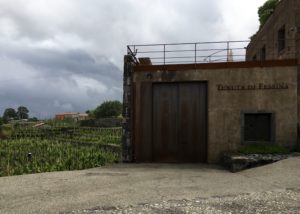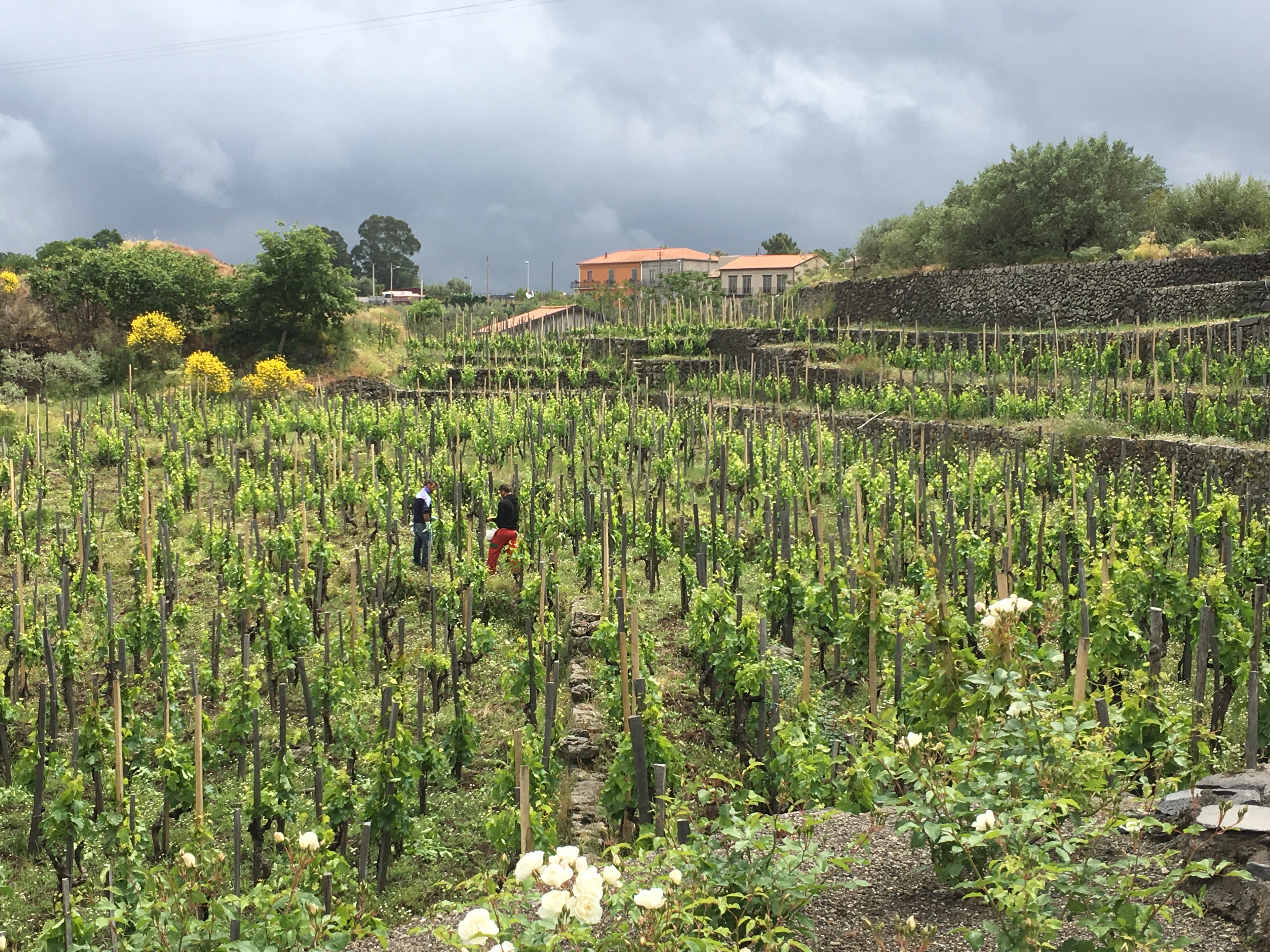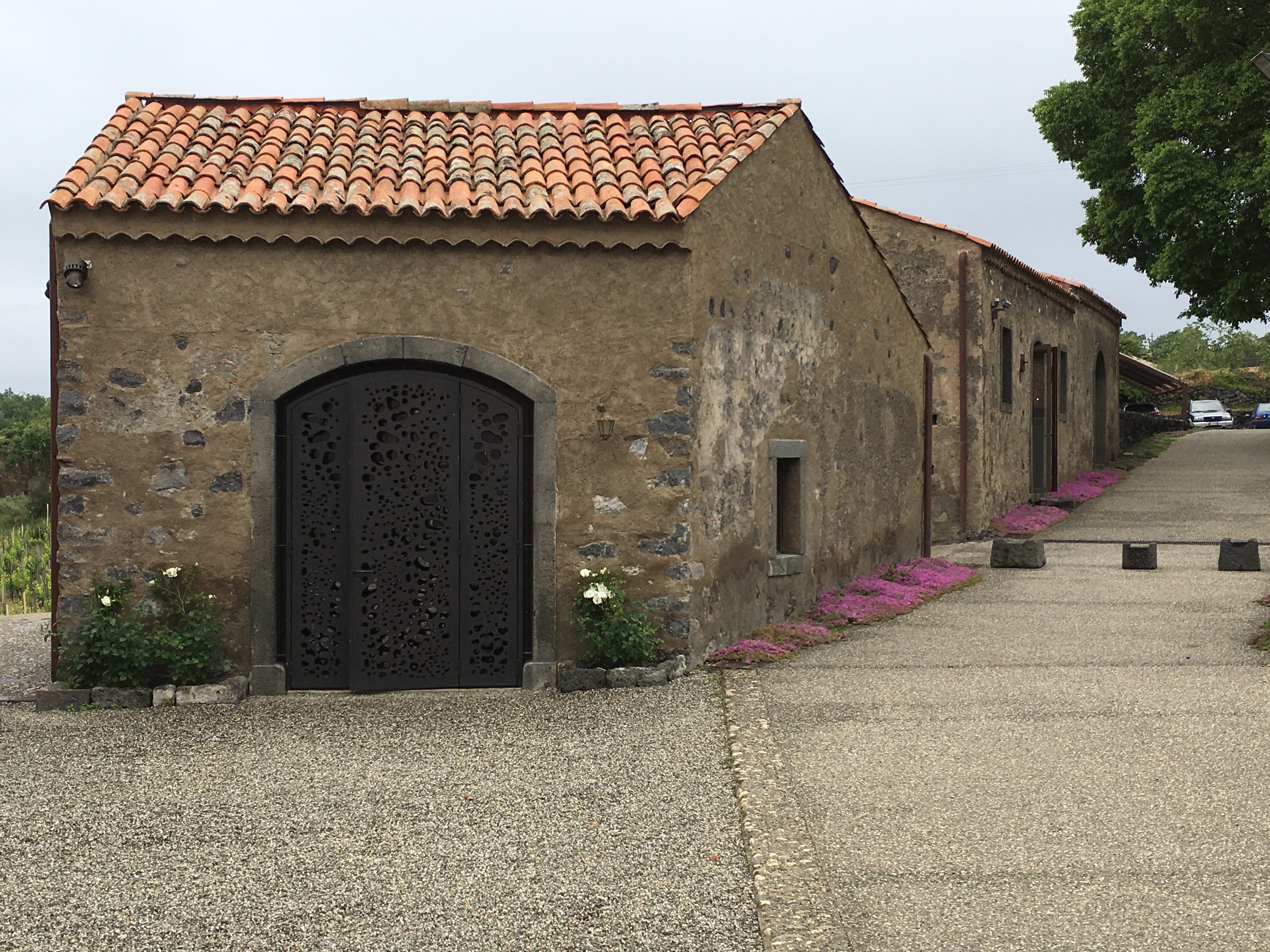My second winery visit on Mount Etna was to Tenuta di Fessina. Fessina was founded by Silvia Maestrelli, a Tuscan who moved here and bought this prime vineyard site in 2007. Silvia had graciously agreed to meet me when I visited, but on our arrival was nowhere to be seen. It transpired that she’d been called away to Milan on urgent family matters. Instead, Silvia’s assistant winery manager, the charming, energetic young Jacopo Maniaci, introduced himself to us and spent the next two-plus hours walking us through the vineyard and winery, and sharing Fessina’s wines with us.
And what wines they are. Back to them in a minute. But first let me share with you a snapshot of this very special place on the northern slopes of Etna.

Located in the tiny hamlet of Rovittello, just across the SS120 which forms part of the road that circumnavigates Mount Etna, Fessina looks northward out over the Alcantara River valley below.
At about 670 m (2,200 ft.) above sea level, the vineyard covers just seven hectares and is partially enclosed by two semi-circular, centuries-old lava flows, one on each side. These gnarled black lava rock ridges protect the vineyard and create a unique micro-environment, evoking comparison to the walls enclosing a French “clos” vineyard such as Clos Vougeot (there’s the Burgundy reference once again…).
The soils are also highly particular, influenced by these specific volcanic eruptions. In a post-visit email exchange, Silvia puts it like this: “Each terroir has tipicity and a unique taste, each eruption has a story and a different soil composition.” So there you have it. This vineyard, with its very old vines, trained in the traditional gobelet system, high planting density and low yields, tells the unique story of those two moments when the Mountain of Fire spoke.
This last is an important point in understanding Etna DOC’s horseshoe-shaped vineyard. It is, both geologically and climatically, not homogenous. Far from it. In Silvia’s poetic words again, in response to me asking whether she thought Etna has a coherent generic identity:
“I would say that the Volcano itself is the [Etna DOC] identity and we are a kaleidoscope of biodiversity that rotate around Etna. The personality is one but the shades are many. There is not just one Etna taste, the unifying singularity [“unicita”] is to have many expressions across the DOC’s almost 1,000 hectares. Etna has one direct identity that encloses many different characters.”
How eloquent. How apt. And how revealing of this magical corner of Sicily.
Back to Fessina’s wines. Jacopo begins with the whites: the Erse Bianco 2016 is 90% Carricante from younger vines; fresh, crisp and acidic, with flinty, ashy and tangy citrus notes. Delicious. Next up is the A’ Puddara 2016, made from 100% Carricante and oak fermented, followed by 10 months on the lees and a further 12 months rest in bottle. A small proportion underwent spontaneous malolactic fermentation. It offers up floral, herbaceous notes with a striking hint of ginestra (broom, which grows all over the area). It too is fresh, but also fuller, more creamy and rounder than the first wine. A step up in complexity and elegance.
The Laeneo 2015 is a rare 100% Nerello Cappuccio, usually the minor component in the typical Etna Rosso blend, supporting Nerello Mascalese. Here it stands alone, after 9 months in stainless steel and one year in bottle, offering up a spicy, aromatic, intense nose that is herbaceous, peppery and also redolent of the Mediterranean island ‘maquis’ (a French word I first learned on Corsica). It tastes clean, pure, fresh (that word again, as ever with Etna’s wines), with soft tannins and a slightly bitter finish. Still youthful, yet delicious too.
The Erse Rosso 2012 is 90% Nerello Mascalese with some Nerello Cappuccio and white grapes too (field blends are not unusual in this area). Its pale garnet colour belies the fresh, vibrant, red fruit nose. Mineral and flint too, along with base elements such as iron, copper and other metallic flavours. It is delicate, elegant, yet racy.
We finish with the Il Musmeci 2012, Fessina’s flagship Etna Rosso Riserva (there is a white version too, but it was sadly sold out), made from 100% Nerello Mascalese. This spent 12 months in tonneaux (500l), a further 8 months in large barrels, and at least four years in bottle. It is a wine of great finesse, which speaks eloquently of its unique terroir. Similar to the Erse but more extracted, with spice, menthol and metallic notes, aromatic herbs and sizzling minerality. Spicy red forest fruit – “frutti di bosco” – flavours cohabit along with those Etna iron, copper and mineral notes, leading to a taut, racy finish. A wine of elegance, classic acidity and ‘verticality’.
Now Jacopo offers us some salami, cheese and bread to go with what remains in our glasses. We learn that his family runs a salami production business up in the nearby Nebrodi Mountains northwest of Etna. This is where the famous ‘suino nero’ (black pigs) live and are raised for the most prized salami in Sicily. We gratefully enjoy the results of his family’s business, washed down with Fessina’s bracing, clean wines.
What a tasting. What a special terroir. For now, at least until the volcano’s next eruption, it is safely in the caring hands of Silvia Maestrelli and her winemaker, enologist Giandomenico Negro, who Silvia tells me was one of the first winemakers to deeply study and research Etna’s indigenous grapes in the 1990s, traveling around the volcano for years studying the different biotypes and varieties around this DOC’s crescent moon. Together, they are creating another chapter in Etna’s extraordinary story.


